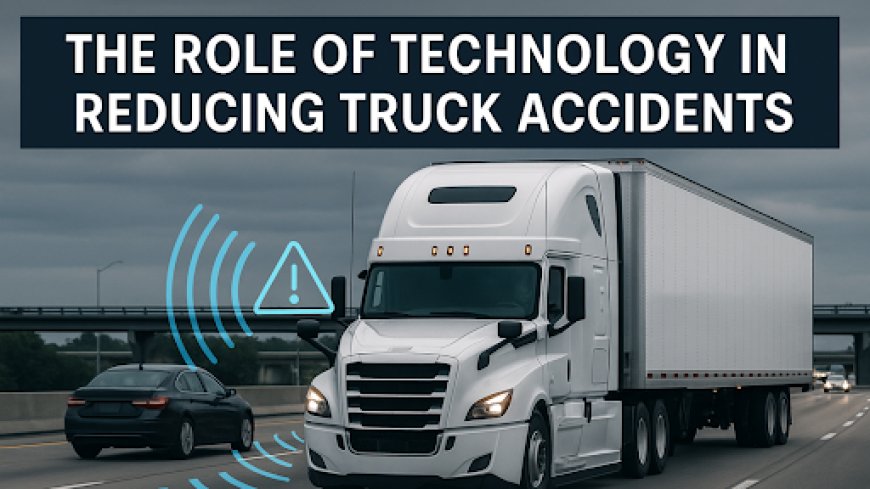The Role of Technology in Reducing Truck Accidents
Fortunately, advancements in technology are playing a pivotal role in addressing the causes of truck accidents, enhancing safety, and ensuring compliance with Florida’s evolving regulations.

Truck accidents are a critical concern in Florida, a state with over 12,000 miles of highways and a bustling commercial transportation industry. According to the Florida Department of Highway Safety and Motor Vehicles (FLHSMV), over 6,000 truck accidents occurred in 2022 alone, many resulting in severe injuries or fatalities. For truck drivers, owners, and operators, safety isn’t just a priority—it’s a legal and financial necessity. Fortunately, advancements in technology are playing a pivotal role in addressing the causes of truck accidents, enhancing safety, and ensuring compliance with Florida’s evolving regulations.
Common Causes of Truck Accidents in Florida
Understanding the causes of truck accidents is the first step toward prevention. In Florida, frequent factors include driver fatigue, distracted driving, inadequate vehicle maintenance, speeding, and blind-spot collisions. The state’s dense traffic, congested urban corridors like I-95 and I-4, and unpredictable weather further amplify these risks. For instance, sudden rainstorms can reduce visibility and traction, increasing the likelihood of jackknifing or rear-end collisions.
Technology Solutions Tackling Accident Risks
1. Collision Avoidance Systems
Modern trucks are increasingly equipped with collision avoidance systems (CAS), which use radar, cameras, and sensors to detect obstacles. These systems alert drivers to potential front-end collisions and can automatically apply brakes if a response is delayed. The National Highway Traffic Safety Administration (NHTSA) estimates that CAS could reduce rear-end truck crashes by up to 50%. In Florida, where traffic congestion is rampant, this technology is invaluable for preventing accidents caused by sudden stops or distracted driving.
2. Electronic Logging Devices (ELDs)
Driver fatigue remains a leading contributor to the causes of truck accidents. To combat this, Florida adopted the federal ELD mandate in 2020, requiring intrastate commercial drivers to use electronic logging devices. ELDs monitor driving hours to ensure compliance with Hours of Service (HOS) rules, reducing the risk of fatigue-related incidents. Real-time data from ELDs also helps fleet managers identify drivers who may need rest breaks, promoting safer scheduling practices.
3. Telematics and Real-Time Monitoring
Telematics systems track vehicle speed, braking patterns, and route adherence. For Florida truck operators, this technology provides actionable insights into risky behaviors like speeding or harsh cornering—common issues on highways such as the Florida Turnpike. GPS-enabled telematics also helps drivers avoid accident-prone areas during peak traffic or severe weather. Companies have reported fewer accidents after implementing telematics, underscoring their effectiveness.
4. Blind-Spot Detection and Camera Systems
Blind-spot collisions are a major hazard in Florida’s tight urban zones. Advanced camera systems and radar-based blind-spot detection tools now offer 360-degree visibility around trucks, alerting drivers to pedestrians, cyclists, or vehicles in adjacent lanes. The Florida Department of Transportation (FDOT) has endorsed such technologies, particularly for routes near ports in Miami and Jacksonville, where traffic complexity is high.
5. Advanced Braking Systems
Anti-lock braking systems (ABS) and automatic emergency braking (AEB) are critical for preventing accidents caused by mechanical failures or poor braking response. These systems are especially vital in Florida’s wet conditions, where hydroplaning risks are prevalent. The Commercial Vehicle Safety Alliance (CVSA) notes that trucks with ABS have 35% fewer brake-related violations during inspections.
Florida’s Push for Technological Adoption
Florida is actively supporting technology-driven safety measures. Beyond the ELD mandate, the state participates in the CVSA’s annual International Roadcheck, emphasizing brake safety and cargo securement. Additionally, FDOT’s Connected Vehicle (CV) Pilot in Tampa uses vehicle-to-infrastructure communication to alert drivers about traffic signals and hazardous road conditions—a model set to expand statewide.
Conclusion
For Florida’s truck drivers and operators, integrating technology isn’t just about staying competitive—it’s about saving lives. By addressing the root causes of truck accidents, from fatigue to blind spots, these innovations are making highways safer while reducing liability and repair costs. As Florida continues to prioritize transportation safety, adopting these technologies will be essential for anyone committed to a accident-free future on the road.
Stay informed, stay equipped, and drive smart. Your safety—and Florida’s—depends on it.
For more information visit us : news.bangboxonline.com
What's Your Reaction?
 Like
0
Like
0
 Dislike
0
Dislike
0
 Love
0
Love
0
 Funny
0
Funny
0
 Angry
0
Angry
0
 Sad
0
Sad
0
 Wow
0
Wow
0





































